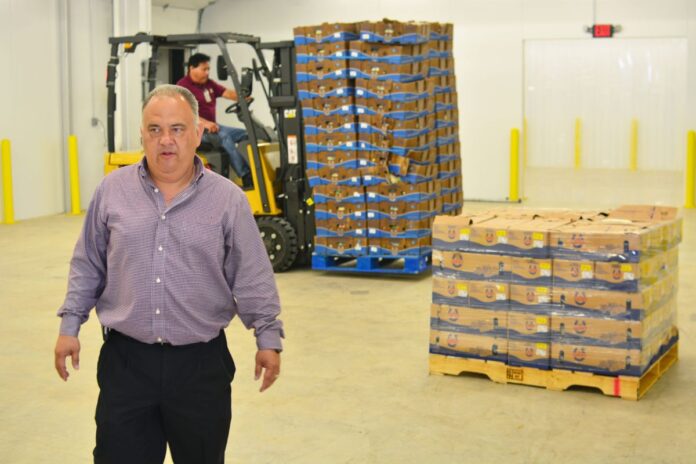LOS INDIOS — As a Mr. Lucky produce truck idled at the dock for an inspection, the cold storage facility at Los Indios was officially welcomed yesterday by local, state and federal officials from the United States and Mexico.
Backers of the $525,000 secondary inspection facility say it is a crucial link in enticing more produce haulers, like Mexican-owned Mr. Lucky, to use the Free Trade International Bridge at Los Indios to move vegetables and fruits into the United States.
“Our concern is not necessarily with all the political issues but it’s about moving forward and making progress,” Cameron County Judge Eddie Trevino Jr., referring to the ongoing NAFTA dispute between the Trump administration and Mexico, told the crowd of 175 people on hand for a ribbon-cutting.
The cold storage facility at the Los Indios bridge crossing has been in development for years. Local officials believe the ability to perform secondary agricultural inspections within cold rooms will make the bridge more attractive to produce shippers from Mexico and increase revenues from tolls and crossing fees to the county and the cities of Harlingen and San Benito.
Prior to the twin cold rooms, and their 2,650 square feet, produce designated for secondary inspections was piled on the dock outside in the Texas heat, breaking what shippers call the “cold chain” and potentially shortening the shelf life of those vegetables and fruits.
A long haul
U.S. Rep. Filemon Vela noted he was first elected to Congress six years ago and he said he recalls discussions about the cold storage facility nearly from his first day in office.
“On the one hand, when it takes that long to get to this point, you can sometimes get frustrated,” he told the audience. “But on the other hand, you realize that when everybody works together, when the federal government and all our friends at Customs and Border Protection, the United States Department of Agriculture, the GSA, Cameron County, the cities of Harlingen and San Benito and Los Indios, you realize that when we all come together we can make things like today come to fruition.”
Vela recalled growing up he often traveled east and west via U.S. 83 or U.S. 281, also known as Military Highway. These days, the old border highway is the target of a major project involving repaving and widening long stretches of the roadway.
Combined with roadway projects to bring I-69 up to federal interstate highway standards, it is making the region into a more attractive area for both east-west and north-south trucking.
“I commend Cameron County, the cities of Harlingen, San Benito and Los Indios, for everything you’re doing to make this corridor a vital part of our transportation system in the Rio Grande Valley,” he said.
How we got here
The roughly half-million-dollar cost of building the new cold storage facility was shared by the county (50 percent) and the cities of Harlingen and San Benito (25 percent each), all of which are part owners of the Free Trade Bridge at Los Indios. The bridge generates more than $2 million in tolls and fees each year.
“It’s good to see so many people out here today,” said Harlingen Mayor Chris Boswell. “I think that’s recognition of what an important and special project this is for our region and for this county and for our communities here today.”
The main produce crossing point into the United States on the southern border is at Pharr, which in the past few years has surpassed Nogales, Arizona, to become the busiest port of entry for Mexican fruits and vegetables. Pharr also has a cold storage inspection facility.
“As we develop this new capability that this port of entry did not have before, a capability to cross produce into the United States through this port of entry without damaging that produce, and as we see more and more produce coming from Mexico coming to the central part of the southern border to reach markets in the eastern part of the United States, we have an opportunity to work together to attract a lot more businesses crossing here in Cameron County,” Boswell added.
Cameron County is in charge of the facility’s daily operation, but operates in a partnership with Harlingen, San Benito, Customs and Border Protection and the General Services Administration, known as GSA.
San Benito Mayor Ben Gomez, who noted most of the work on the facility was performed prior to his recent election, said he has nevertheless seen the partners working together and has been impressed by their dedication.
“It takes a lot of people to get something like this going, and I’m very proud of you guys for doing this,” he said, “and yes we need to stick together (and stay) positive and we can accomplish a lot of things.”
Cold storage facility at Los Indios
• Two climate-controlled rooms
• Square footage of 2,650 feet
• Cost was $525,000
• Ownership is 50 percent Cameron County, and 25 percent each Harlingen and San Benito
• Partnership group is Cameron County, Customs and Border Protection, General Services Administration, Harlingen and San Benito




